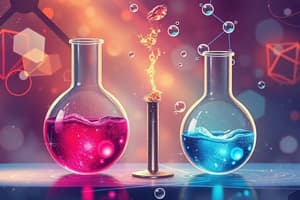Podcast
Questions and Answers
What is chemical equilibrium?
What is chemical equilibrium?
A state in which the populations of at least two states are constant.
Most chemical reactions are irreversible.
Most chemical reactions are irreversible.
False (B)
According to Le Châtelier’s Principle, what happens when the concentration of reactants is increased?
According to Le Châtelier’s Principle, what happens when the concentration of reactants is increased?
- The equilibrium shifts toward the products (correct)
- The reaction stops
- The equilibrium shifts toward the reactants
- There is no change in equilibrium
What does the equilibrium constant (K) describe?
What does the equilibrium constant (K) describe?
What does a K value greater than 1 indicate?
What does a K value greater than 1 indicate?
What is the function of an acid in a chemical reaction?
What is the function of an acid in a chemical reaction?
What is an amphiprotic species?
What is an amphiprotic species?
What is a buffer solution?
What is a buffer solution?
In an aqueous solution, H+ will exist as the ______.
In an aqueous solution, H+ will exist as the ______.
A weak acid is always determined to donate hydrogen ions.
A weak acid is always determined to donate hydrogen ions.
Flashcards are hidden until you start studying
Study Notes
Chemical Equilibria
- Equilibrium occurs in a system with at least two states when populations remain constant.
- Chemical reactions are often reversible, allowing reactants to form products and vice versa.
- Double arrows denote reversibility and dynamic equilibria.
Le Châtelier’s Principle
- Systems tend to restore equilibrium if disturbed.
- Changes in reactant or product concentrations shift equilibrium:
- Adding reactants pushes the equilibrium toward products.
- Adding products favors the formation of reactants.
- Example: High oxygen tension in alveoli promotes oxygen binding to hemoglobin; lower tension in tissues promotes release.
- Volume and pressure changes also affect equilibrium:
- Increased FiO2 raises dissolved oxygen levels.
Equilibrium Constant
- The equilibrium constant (K) quantifies the balance of reactants and products in molar concentrations.
- For the reaction aA + bB ⇌ cC + dD, K is expressed as:
- K = [C]^c [D]^d / [A]^a [B]^b
- Subscripts indicate specific types of equilibrium (e.g., Ka for weak acid ionization).
- K values > 1 indicate a product-favored reaction, meaning products are more prevalent than reactants.
Acids and Bases
- Acids increase H+ concentration; in solution, H+ is typically present as hydronium ion (H3O+).
- Bases increase hydroxide ion (OH-) concentration in a solution.
- In Brønsted terms:
- Acids donate H+; bases accept H+.
- Example reaction: HCl → H+ + Cl-, where Cl- is the conjugate base that can accept H+.
- Amphiprotic species can function as either an acid or a base, such as bicarbonate (HCO3-).
- Polyprotic acids, like carbonic acid (H2CO3), can donate more than one H+, with initial protons released more readily than subsequent ones.
Weak Acids
- Weak acids partially donate H+ to bases; their dissociation establishes dynamic equilibrium.
- The equilibrium constant (Ka) measures this equilibrium:
- Larger Ka indicates stronger acids.
- Example: In plasma, carbonic acid dissociates with a Ka of 7.94x10-7, leading to a pKa of 6.1.
Buffers
- A pH buffer resists changes in pH; typically comprises a weak acid (HA) and its conjugate base (A-).
- Adding a strong acid reacts with the weak base in the buffer to form more weak acid:
- Reaction: A- + H+ → HA
- Adding a strong base reacts with the weak acid to yield water and the weak base:
- Reaction: HA + OH- → A- + H2O
Studying That Suits You
Use AI to generate personalized quizzes and flashcards to suit your learning preferences.



